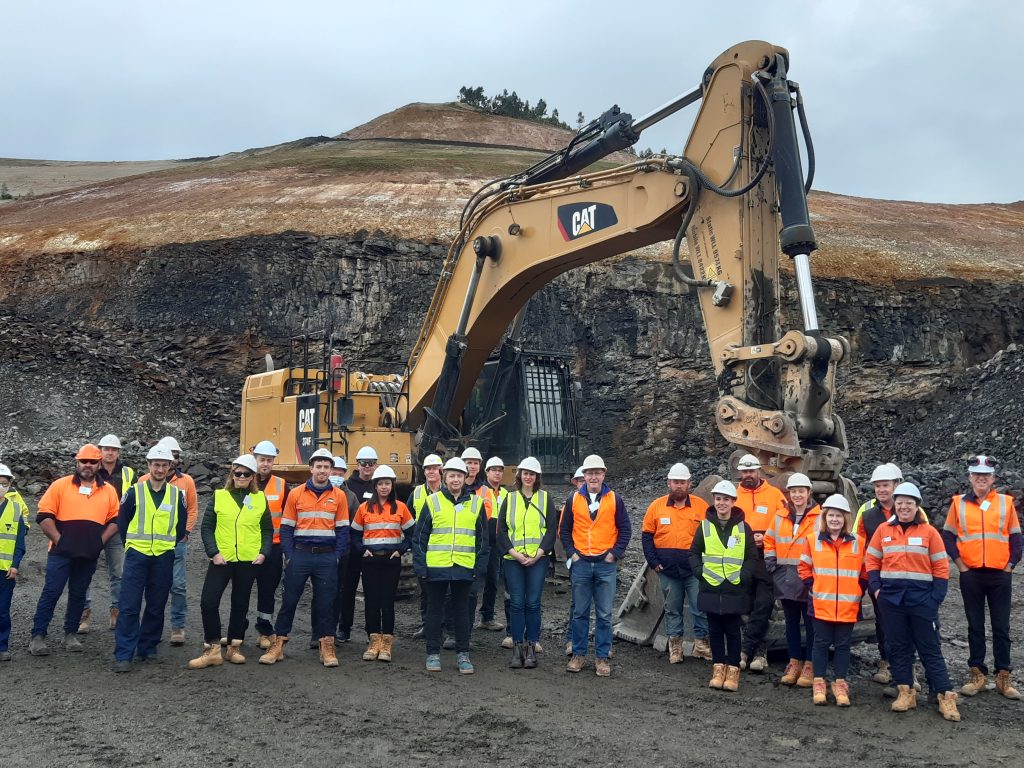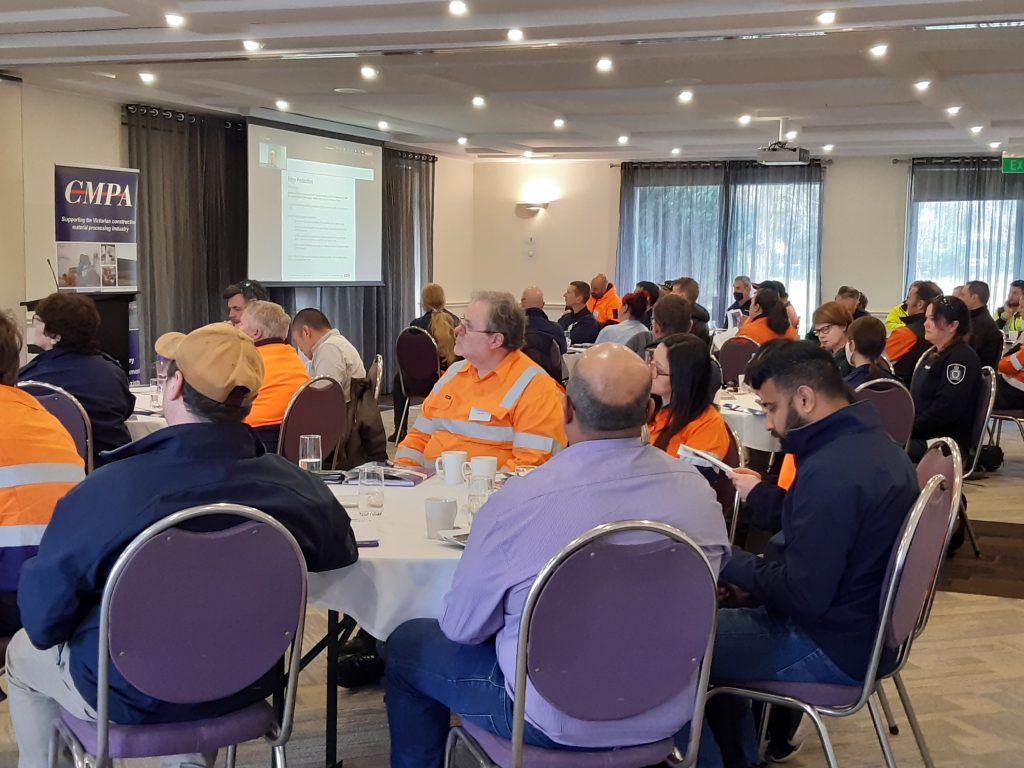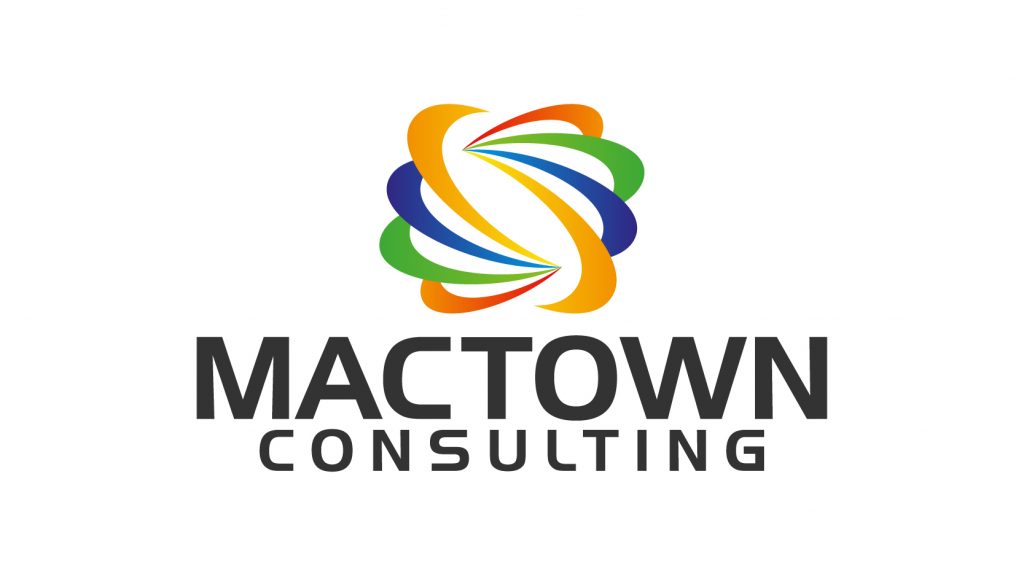Members Day 2022 – Working Safely with Geotechnical Risk in Quarries Workshop
GAVIN MOREIRA, Member Services Manager for CMPA provides an update on the Working Safely with Geotechnical Risk in Quarries Workshop held in Traralgon.
On 4th August 2022, the CMPA held a workshop to support Members in meeting the requirements of the Victorian Occupational Health and Safety Act 2004 and the Mineral Resources (Sustainable Development) Act 1990 (MRSDA) by ensuring that:
• Geotechnical hazards associated with quarry ground movement and quarry operations are identified, assessed where required and then controlled in a manner to reduce the risk of personal or vehicle engulfment; and
• Quarry infrastructure is established in a manner so as to prevent vehicles that have lost control, or persons working close to edges from falling to another level.
The first activity for the morning was a site visit to Matthews Quarries by coach. On board was Manager Jason Comben who gave us a run down on the site as we were driving around the quarry. The first stop was near the main face where we were greeted by Quarry Manager Nelly White who gave us an update on the site in relation to Geotechnical Risks followed by discussions by one of our sponsors Basil Natoli of BCA Consulting who provided a geological history of the quarry. The next stop was a brief overview of the current crushing plant operations which was not operational at the time.

Once back at the hotel and following morning tea our first presentation was made by MS Teams from Wally Morrison, Principal Mining Engineer, WorkSafe who presented on Geotechnical Awareness in Open Pits/Quarries.
• Modes of Ground Failure: Material strength, structure and trigger events
• Pit Design: Aspects that influence geotechnical risk
• Dumps and Stockpiles: Factors that influence stability
• Implementation and Monitoring: Blasting, excavation and slope performance
• Geotechnical Risk Controls: Practical approaches to geotechnical risk and means of compliance
• Fall from Height Controls: Practical approaches to FfH risk and means of compliance
Next up was Karen Sonnekus, Principal Geotechnical Engineer from Earth Resources Regulation who presented on the new Geotechnical Engagement Sessions for work plan approvals process. Geotechnical risks are associated with ground movements in or around a quarry. Ground movements may vary from minor to significant (such as subsidence or natural rebound) or catastrophic (such as slope failure). For further guidance see Geotechnical guideline for terminal and rehabilitated slopes extractive industry projects (www.ecodev.vic.gov.au). The first geotechnical engagement session should be held shortly after the first site meeting and once the technical investigation scope has been confirmed.
• The technical consultations improve proponent understanding of ERR’s technical requirements and subsequent application quality.
• This will likely reduce the change requests required and time for geotechnical report review following submission.
• It is also an opportunity to share geotechnical learnings from other similar sites.
For further information see Geotechnical Engagement Sessions:
Information for Proponents (www.ecodev.vic.gov.au)
After lunch, a sponsor’s video was given by Anita Macartney of Mactown Consulting who provided an insight on her background and a new project she is working on with WorkSafe, it is basically the development of a safety management system, training, and bowties for small-medium quarries who may not have safety professionals.

David McKelvie of SafeMix presented next providing us with an update on the latest Working Safely with Geotechnical Risk in Quarries Guideline. The purpose of the Guideline being to support CMPA Members in ensuring that:
• Geotechnical hazards associated with ground movement and operations are identified, assessed where required and then controlled in a manner to reduce the risk of personal or vehicle engulfment; and,
• Quarry infrastructure is established in a manner so as to prevent vehicles that have lost control, or persons working close to edges from falling to another level.
To achieve the above the Guideline focusses on pit design and water management, the two most critical elements of winning source materials in a safe and economical manner.
This guideline also informs and supports CMPA members by providing guidance when:
• Sourcing information for establishing/applying for a Work Plans/Work Plan Variations;
• Sourcing training information and materials related to surface extraction operations;
• Planning and establishing quarry infrastructure;
• Preparing risk management and Ground Control Management Plans;
• Identifying and managing risks during planning, design, operations, and rehabilitation.
The final presentation was from Sanjive Narendrathan, Technical Director – Mine Geotechnical Engineering, GHD and Nirav Patel, Senior Geotechnical Engineer, GHD Pty Ltd who updated the guide for changes in legislation and how this has been translated by ERR into requirements for the control and
management of geotechnical risk.
Overview of GHD presentation:
• Legislative updates for the extractive industries;
• Intent of Working Safely with Geotechnical Risk in Quarries version 2 of the Guidelines;
• Key additions from previous Guidelines;
• Structure of Guidelines;
• Preparing a Geotechnical Assessment;
• Preparing a Ground Control Management Plan.
The CMPA much appreciates the willingness of these different Victorian Government entities to present at the Workshop enabling better understanding of CMPA Members’ responsibilities.
Note that the Geotech Workshop was recorded and will be made available to CMPA Members at a later date. The Working Safely with Geotechnical Risk in Quarries Guidelines version 2 are currently being amended for comments from CMPA Members and Government Regulators and are expected to be published on CMPA’s website 31 October 2022.
Thanks again also to all the presenters and to our Geotech sponsors BCA Consulting and Mactown Consulting.











You must be logged in to post a comment Login